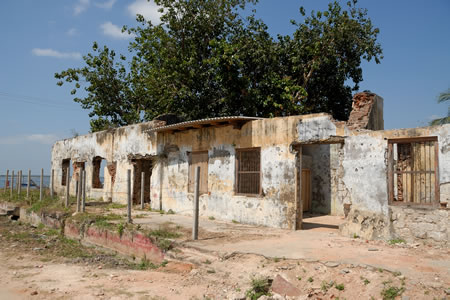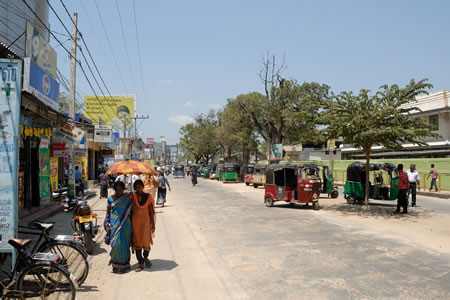English | Dutch |
|
| A visit to Jaffna | |
Anuradnapura (Sri Lanka), March 10th 2011
|
|
| |
|
With one more week to go, of our total visit of six weeks to Sri Lanka, we had the feeling that we got a very good impression of this island state. There was as a matter of fact, only one thing left we really wanted to do in Sri Lanka: experiencing a less visited part of the country. Sri Lanka is a popular holiday destination, not only for individual travellers but also for different kinds of tour groups, making it difficult to find interesting places where you can still experience the ‘real’ Sri Lankan life. Most places are run over by tourists, and that isn’t surprising, because Sri Lanka is a beautiful place and easy destination to visit. At first, we considered to visit the eastern part of Sri Lanka. The cities Ampara, Batticaloa and Tricomalee are relatively less visited. However, the problem was that the eastern part of the country was rainy at the time we considered going there. For a matter of fact, the weather in the whole country was distressed. It rained in places that should be dry at this time of the year, resulting in huge flooding in the central and eastern part of the country. Eventually, we decided to try to bring a visit to the most northern part of the country, the city of Jaffna. The nice thing about a visit to Jaffna is not only a visit to a seldom visited area of the country, but also a visit to a part of the country where the Tamil people form the majority. So, visiting Jaffna would not only give us the opportunity to meet the Sinhalese people who live in the central and southern part of the country, but also the Tamil population of Sri Lanka that mainly live in the northern and eastern parts. |
|
 |
|
Silent remains of the civil war in northern Sri Lanka |
|
A visit to the northern part of Sri Lanka is still not straightforward. The area was till a couple of year ago, battleground in the civil war between the Sri Lanka Army (SLA) and the Liberation Tigers of Tamil Eelam, or often called the Tamil Tigers. For that reason, foreigners need a permit from the Sri Lankan Ministry of Defence, before they can travel to this region. The crux of the conflict between the government and the Tamils was the feeling of the Tamils (mainly Hindus), justified or not, that they were discriminated against the majority of the Sri Lankan people, who are the so-called Sinhalese people (mainly Buddhists). This feeling appeared just after the British left and Sri Lanka became and independent state. The Tamils asked for a federal system in where the Tamils got more autonomy for their region, but when the government did not comply with this wish, some young Tamils picked up the arms and started fighting for their own state, which should get the name ‘Eelam’, which means Precious Land in the Tamil language. But the only thing the war led to, like all wars, was a lot of misery and many civilian casualties. The Tamil Tigers controlled big parts of northern and eastern Sri Lanka during the 30-year conflict, but by the spring of 2009, they were defeated by the Sri Lankan Army which crushed them in a long and heavy military operation. Some people are of the opinion that the SLA used too much violence, resulting in many unnecessary civilian casualties. That’s why some argue that Sri Lanka’s leaders must justify themselves before a war tribunal. At the moment it is quiet in the region, but it is not sure yet if the reason of the dissatisfaction of the Tamil people, which led to the violent war in the first place, left with the defeat of the Tamil Tigers. We decided to go and travelled to Colombo first, to apply for the travel permit to Jaffna, which took 72 hours to get. Till for a couple of months ago, it was only possible for foreigners to travel to Jaffna by airplane. That condition is fortunately lifted, which means that nowadays travellers can also travel by bus over the infamous A9 highway. This highway crosses the so-called ‘the Vanni’ a region that was often the battlefield of the conflict. The road is for a couple of years under governments control again, and after some necessary repairs, the road is open again. We first took a public bus from Colombo to Vavuniya (6.5 hours), where we changed to the public bus that took us to Jaffna. The remaining four hours took us over a partly repaired road, but the ride was still not very comfortable. | |
 |
|
Present-day life in Jaffna |
|
| The ride through the Vanni was impressive. This flat, savannah-like area has taken a lot of human toll in the last decades; you can see it everywhere. Many buildings along the route are destroyed, areas are still fenced off by red tape because of the mines, and now and then you see a rusty tank next to the road. The whole A9 is a ribbon of military activity, from camps and barracks, to bunkers in where armed soldiers are keeping an eye on the road. We made a short stop in the small town of Kilinochchi, the proposed capital of the Tamil country Eelam, where the Tigers fought for. It isn’t really a town. It is more like a small and dusty village where the results of the war are still very visible. Many building are destroyed and not rebuild yet, which means that some businesses, like a bank for example, resumed their business from a sea container.
We experienced Jaffna as an extremely friendly place. As soon as you arrive at the bus station, you notice that this place hasn’t seen a lot of travellers yet. Rickshaw drivers are not overcharging foreigners and everybody is sincere happy to see travellers again visiting their part of the country. It is a signal for them that the misery has left and that can think about their future again. Jaffna is a place where the rebuilding made already some progress. New buildings appeared everywhere in the city and many roads are repaired. But it is also still visible that Jaffna was disconnected from the other parts of the country for a long time. Most people still use the bicycle to get around, and the sporadic taxi and truck you see are from the 50s and 60s of last century. In the area that is located on the south-eastern side of the old Dutch fort, which is not open to public because of its function as military barrack, you can still see the results of the war. Many building are destroyed and the thousands of bullet holes in the ruins proves that heavy fighting took place in this formerly administrative district of the town. Let’s hope that the peace will last and that this part of Sri Lanka can develop like the other parts did. The potency is definitely there. | |